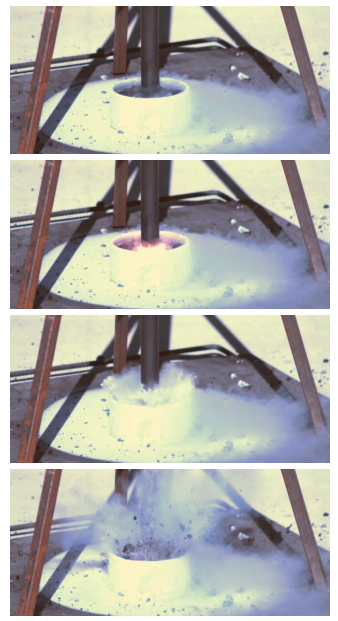High-speed vision systems help researchers investigate the combustibility of liquid oxygen so they can reexamine its hazardous material status.
Historically, firefighting schools and other emergency response educators have taught the dangers of hazardous materials like liquid oxygen (LOx). Ensuring first responders know of LOx‘s dangerous potential helps protect emergency personnel from harm.
At the same time, however, exercising caution beyond practicality could endanger innocent lives. For example, the current hazardous materials (HAZMAT) rating for LOx states that first responders cannot enter the site of a spill until 30 minutes after all the frost has evaporated. Yet in many emergency situations — like a crashed LOx tanker on a highway — it is likely that injured persons require urgent medical care and cannot wait over 30 minutes for assistance.
In an effort to reexamine LOx’s HAZMAT status and save more lives, fire researchers are using Phantom highspeed cameras to investigate LOx’s combustibility.
Igniting the Investigation
Both researchers and in-training firefighters are put to the test at the Utah Fire and Rescue Academy (UFRA) of Utah Valley University (UVU). In one common exercise, firefighter students attempt to extinguish flames within a storage container known as the Fire Box, which has been filled with gasoline-doused wooden pallets. This exercise acclimates students to rushing into enclosed spaces to extinguish raging fires.
Brian Patchett, the Demonstration and Equipment Manager for the Physics Department at UVU’s College of Science, also uses the Fire Box to conduct his cooperative research with UFRA in an effort to answer the question: Is LOx that dangerous? By shedding more light on the dangers of LOx, Patchett and his research team hope to open up a new conversation to reevaluate LOx’s hazard rating. Additional insights could lead to shortened response times, increasing the likelihood that injured people receive emergency care within critical timespans.
Designing the real-world LOx experiments
Encouraged by the real-world ramifications of their investigation, Patchett and his team designed their experiments to simulate how first responders would address a LOx spill. To accomplish this, the team used the Fire Box, located in the center of the UFRA warehouse.
After spilling LOx onto surfaces like concrete and asphalt, the researchers struck the surfaces with various tools like a crowbar, hammer and a Halligan bar (a firefighting tool) to see if a reaction occurred. As LOx is considered a highly reactive oxidizer, the team also mixed LOx with common hydrocarbons like oil and diesel to investigate the reactions. Additionally, the team tested different ignition sources like sparks and direct flames. Together, these different surfaces, fuels, objects and ignition sources represented a realistic emergency response scenario.
As the researchers attempted to start the fire, Patchett sat inside the Fire Box in the explosion radius, with one regular camera and one Phantom VEO 1310L high-speed camera pointed at the action. Protected by a clear plexiglass shield, he focused the cameras on the impact points to record any possible ignitions. These experiments required high frame rates, enabling the researchers to capture the exact moment of ignition and see how the combustion propagates.
Patchett began each experimental run by recording the impact at 900 x 900 resolution and 20,000 frames per second (fps), initially checking to see if any reaction occurred. When the researchers noticed a reaction, they repeated the experiment — this time increasing the Phantom camera’s frame rate to 30,000 fps at 800 x 600 resolution.
Because the resulting high-speed files were so large, the Phantom camera captured one reaction at a time. Once he finished recording, Patchett downloaded the file to a computer and then reset the camera for another run. Repeating this process, the team performed up to 100 experiments per day.

|
| IMAGE: Using a spark ignition source, the team ignites the LOx-doused carpet sample. |
 The Phantom VEO 1310L provided the high frame rates necessary for the research team to capture the experiment. Featuring a highly sensitive CMOS sensor that delivers 1280 x 960 pixel resolution at 10,860 frames per second, the camera allows the researchers to visualize the reactions with high fidelity. Additionally, the camera’s compact and durable design ensured performance in the rugged research environment. The Phantom VEO 1310L provided the high frame rates necessary for the research team to capture the experiment. Featuring a highly sensitive CMOS sensor that delivers 1280 x 960 pixel resolution at 10,860 frames per second, the camera allows the researchers to visualize the reactions with high fidelity. Additionally, the camera’s compact and durable design ensured performance in the rugged research environment.
Getting fired up over promising results
Thanks to having high-speed footage, Patchett and his team were able to determine where the ignitions originated and how they started. Such insight can inform the design of better safety practices to provide support while maintaining firefighter protection.
Specifically, the team learned that roughly 10 percent of the simulations resulted in an explosion — far less than originally anticipated. By redefining the previous understanding of how LOx behaves, a very specific set of conditions must be met for high combustibility and explosiveness.
While the team doesn’t directly influence LOx’s hazard status, the results of the experiments are vital in its reevaluation. Going forward, Patchett plans to use Phantom high-speed cameras to support the forensics department’s blood spatter research.
IMAGE: A heavy rod impacts the sample and ignites the LOx.
Adept Turnkey acknowledges the work done by Dr Patchett and his team at Utah Valley University and the source of this article is from Vision Research Inc.
Need a price or more application information? Please
email Adept Turnkey or call our offices
Adept Turnkey Pty Ltd are "The Machine Vision and Imaging Specialists" and distributor
of Phantom High-Speed products in Australia and New Zealand. To find out more about any Phantom High-Speed Camera,, please call Adept Turnkey at Perth (08) 9242 5411
/ Sydney (02) 9905 5551 / Melbourne (03) 9384 1775 or contact
us online. |
|